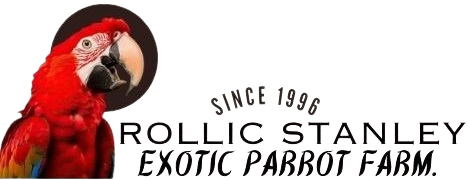THE CAGE
Whenever possible, try to purchase the largest cage that you can afford and accommodate that is suitable to the species of bird you purchased. Minimally, the cage should allow for the bird to spread its wings without touching the sides of the enclosure. Anything smaller is too small.
The cage should also be wider than it is tall, yet still tall enough to accommodate the bird’s tail. Avoid cages that are tall and cylindrical. These types of cages aren’t very practical and don’t offer the bird useful room. Also, avoid cages with ornamental scroll work. Birds can get their leg bands and heads caught on the loops.
Powder coated or stainless steel cages are excellent choices. They are both practical and long lasting, in addition to being very attractive and easy to clean.
Bar spacing is also a very important consideration. If the bars are spaced too far apart, smaller birds may be able to slip through or get their heads wedged between the bars. Even if they don’t get their heads stuck, it still presents a danger in homes with other predatory animals like cats and dogs. The cage should also have some horizontal bars so that the bird can climb around the cage easily.
The table below lists the minimum recommended cage sizes for the various species we raise.
LINING THE CAGE
There are a variety of bedding materials on the market that can be used to line the cage. We feel the best cage liner is newspaper covered with a layer of ground walnut shell. This type of bedding work wonders at controlling odor and are environmentally safe.
A grate with adequate distance between the cage and lining pan is a must in order to prevent the bird from having access to droppings and discarded food.
Perches
More than one perch should be supplied and they should be of different diameters in order to help feet stay healthy and provide good foot exercise. Perches should be sized to allow comfortable perching. Perches that are too large or too small in diameter do not allow the bird to properly grip, and this can lead to foot problems.
Perches need to be sturdily mounted and should not move or vibrate under the weight of the bird. They should also be high enough to prevent the bird’s tail from coming into contact with the bottom of the cage but not so high that the bird has to bend its head to avoid contact with the top of the cage. Also, position the perches in such a way that the bird’s droppings won’t soil the food, water, or other perches.
Sandy Perches should be used in combination with wood perches to assist in dulling sharp nails. However, concrete perches should never be used as they can create foot sores.
Toys in the Cage
Toys are very useful and very necessary in a bird’s world. They are mentally stimulating and encourage your bird to exercise. A bird that is deprived of diversion will quickly become a perch potato. It is best to provide your bird with both destructible and indestructible toys.
There is no quality control regarding pet bird products. It is, therefore, up to you to be aware of potential hazards and to keep safety in mind when selecting toys for your bird.
Choose toys that are free of toxic materials, sharp objects, or small easily consumed parts. Good choices will vary in shape and color as well as stimulate activity and fulfill a bird’s natural tendency to chew.
Toys should be made of very strong materials, especially for the large Macaws and Cockatoos. In addition to wood toys for chewing, acrylic toys are also recommended. Acrylics are a little more expensive but they are generally safe and long lasting.
Select toys that are size appropriate for the bird. Toys designed for small birds should not be used for large birds. Small bird toys may contain parts that a large bird will easily consume. Additionally, large bird toys may contain parts that are large enough for a small bird to get its head or other body parts caught in.
Some toy components are safer than others. Avoid toys with open chain links, snap type clasps, and bell clappers. Safer choices are toys containing screw type clasps and closed chain links.
Try not to overcrowd the cage with so many toys that it becomes an obstacle course that the bird must maneuver just to get to its food and water. Parrots are natural chewers so be prepared to replace toys and perches on a regular basis.
